Can The Thoroughbred Still Jump?
Alert Readers: this article has been fact checked, info at the end
The Contraversy:
A new industry narrative has arisen questioning the Thoroughbred as a viable sport horse for Olympic style sport and as a legitimate source of jump genetics. It goes like this: The Thoroughbred isn't a jumper breed, and it can't jump high, and while it may have had a jump at one time, that it no longer does, and therefore is useless for upper level competition or as an cross for sport horse breeding.
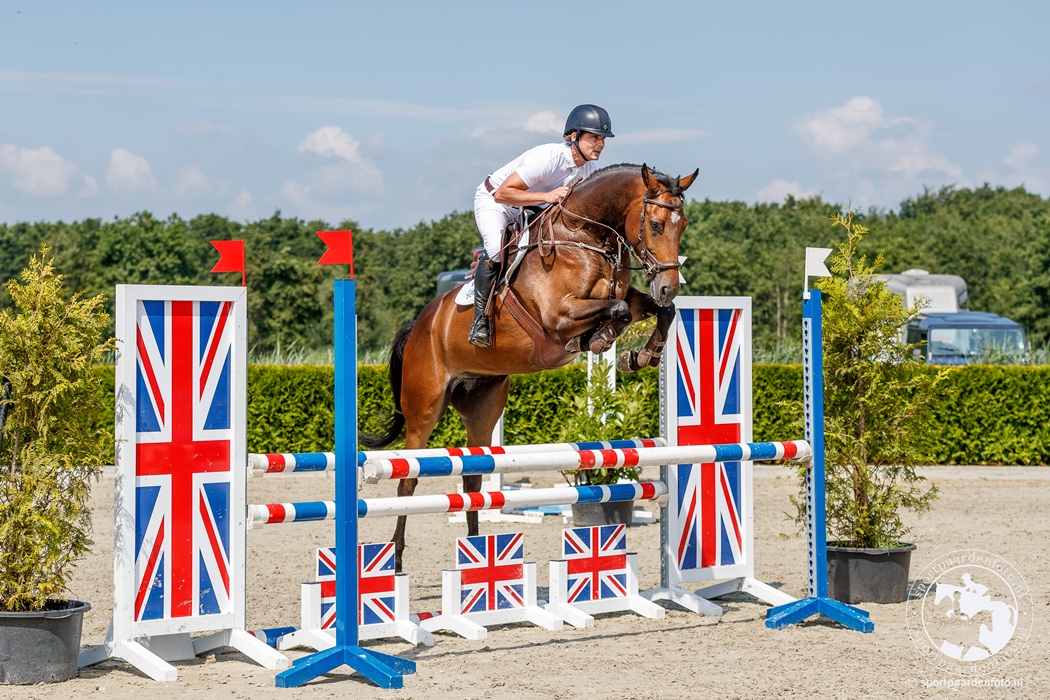
[Olympian Theo van de Vendel on a talented young member of his string, Krackerjack, 85.5% TB.]
I ran into this version of the new dogma when I posted the running of the 2021 Virginia Gold Cup, a upper level steeplechase of 4 miles with 23 timber fences, in a few sport horse groups. The horses in the race are Thoroughbreds. Interesting discussions erupted in the comment section about the jump in the Thoroughbred, a trait that I have long contended is inherent in the breed. As a breeder, my understanding is that genes do not change ( a view shared by Dr. Bowling in Horse Genetics), that they travel down through the generations unchanged. Jumping is an inheritable trait, and proven jump bloodlines are easily identified. And the Thoroughbred is a purebred breed with a closed studbook, so its genetics have not become diluted by cross breeding with non-jumping stock. Not everyone agrees with me about the Thoroughbred being a jumper breed.
Two very experienced sport horse professionals disagreed with me, saying that the Thoroughbred used to have lots of good jumpers but now it does not. They said many can't jump at all and others don't jump well. I thought it odd this opinion was being floated when they were watching the proof that the Thoroughbred has a very big jump indeed (running of the Virginia Gold Cup). The jumps in the race were timber fences, not hurdle fences that a horse can brush through, but solid wood fences of 4' to 5' that require a horse to arch over like a show jumper's bascule in order to clear them without injury. I looked up the height of upper level show jumps (level 9) and saw that they are set at 4'9", and in Grand Prix, the highest level, they are set at 5'3", plus show jumpers are jumping on level groomed surfaces, not launching from uneven ground like the racers. So then, basically, a upper level jumper needs to be able to clear 5', and so does a upper level steeplechaser, so we can see the Thoroughbred does have a jump today.
The next point made against the Thoroughbred was that the percentage of Thoroughbreds that can really jump is very low compared to the warmblood jumper. But there was no percentage provided from either breed. One of the Thoroughbred critics said the horses in the steeplechase we were watching were the exception, not the norm. But that can be said in any upper level competition of any sport. And truly, how would they know when very few Thoroughbreds are ever given the chance to jump, most are used in racing alone. And what percentage of the warmbloods make it to Grand Prix? I contend that the number is very low for the warmblood as well. So, I feel that was and is an unfair and incorrect assessment, and that it means nothing. Another critic said that you just can't find a good Thoroughbred to cross in anymore. The point being it is difficult to find a sire now-a-days like Ladykiller, Precipitation or Golden Beaker for examples.
These comments were accompanied by the recent industry buzz-word 'purpose-bred'. And now I feel we are getting to the real meat of the issue. I have run into this industry philosophy many times in the past as it is always used to dismiss the American pure-bred sport breeds, not just the Thoroughbred, but the Saddlebred, Morgan, Standardbred and others, from suitability for Olympic style sport. And it is proclaimed, like a trump card, to erase any other breed from the arena. Its a strange choice of phrase, because if you are breeder of horses, you 'purpose-breed', that is, you have a breeding goal, and you direct your stock choices and breeding designs to achieve that goal. But that is not what is meant when this phrase is thrown down as it was here, what they mean is the European Warmblood method of doing things, and the implication they are making is all other purpose-bred programs are invalid.
Because the people I was discussing this issue with were very informed, I needed to double check my own stance, because maybe I was so far out of the loop that I had missed a great sea-change that had recently occurred in the Thoroughbred and it genetics. So I opened up this discussion in a Thoroughbred rehoming group, just to get the opinion of the owners and trainers of off the track Thoroughbreds (OTTBs) to see if they found that the jump has disappeared from the breed. These people have to evaluate the fresh off the track horses, then retrain them and place them into new disciplines, so surely they would have noticed this great change in type. On the whole they said no, that the Thoroughbreds are wonderful jumpers, not just having the athletic ability but the courage to take on the scary jumps, one of them pointing out you can jump a Thoroughbred through a ring of fire, and that they were also incredible cross-country jumpers. Several did mention that some people who try Thoroughbreds never realize that you cannot use the same heavy handed methods commonly employed in the warmblood training and riding to get them to perform, because the Thoroughbred is more sensitive and will resent that type of handling and not perform well. A few other riders there brought up the 'purpose-bred' mantra as well. One summing it up with "the warmblood breeders select for jumping techniques (or dressage movement), in the Thoroughbred breeders are selecting for various types of racing abilities." Once again the unspoken idea is that because the majority of breeders of Thoroughbred are not breeding for jumping specifically (of course some are, but the racing industry is huge in comparison) that the jump has disappeared or perhaps faded out. That line of thought, however, is impossible genetically in a purebred breed, you don't lose the jump genetics, but you sure can make other factors more dominant by selection, so maybe that is what some are experiencing.
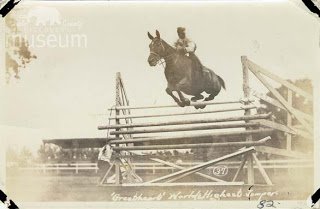
Coming from the historical and pedigree side of things I knew that the Thoroughbred was the greatest source of jump genetics in the modern sport horse, with the Trotter, a close relative, coming in second. As you can see above the horse has a jump so powerful he cleared 8'3", the true world record for high jump--that is 3 feet higher than the Grand Prix jumpers are asked to do. The horse pictured is Great Heart, a Hackney/Thoroughbred cross, the record was set at Fort Sheridan in 1923, he repeated it later that year. Another full Hackney, Confidence won the high jump with 8' 1 1/2", and most know of the Thoroughbred Huaso who jumped 8'1" in 1949. So, I cannot give even a moment to the notion that the Thoroughbred (or the Trotter) was never a good jumper. The challenge then is to address their position that the Thoroughbred is no longer a jumper breed.
Their strong argument put forth was a horse must be bred in a system like the European Union instituted, what they now call 'purpose-bred', in order to be considered a real sport horse. This stance of course invalidates our purebred sport horse breeds in America because according to their decrees our breeds cannot be considered sport breeds because they don't set up a government run stud system like Europe does. The unfortunate side of this attempt in market domination, is that when the young equestrians hear this enough it makes sense to them. They never question those experts, nor do they consider why would our sport breeds, that historically were always sport horses, bred for excellence in hunt, racing, jumping, saddle and carriage for hundreds of years need to be purpose-bred for something that they already are? And being pure-bred the genetics that produce performance have not gone away or changed--it is a genetic impossibility. They fail to see that the European horses needed to be purpose-bred in order to elevate them into sport horses from a draft horse base. We have no such need here. Few of the modern day equestrians comprehend that the pressure behind this whole narrative is marketing, to continue to sell their horses worldwide, and to suppress other legitimate sport horse suppliers from hurting their market. Instead they accept the story that horses have to bred in this system to be good sport horses.
As I mentioned above the idea that the jump genetics evaporated from the Thoroughbred is impossible genetically, they have a closed studbook. Now within that closed population there is variation in what each horse expresses, indicating the various traits that the breed carries and could have been made dominant in a individual horse by selective breeding. If you breed a sprinter to a sprinter, the odds are you will get a sprinter, and if you keep that focus on for future generations, then you will get a sprinter typesetter. Does that mean the jump trait was eliminated? No, first many sprinters can jump well, but it means the sprint phenotype may become the dominant expressed characteristic. Let's look at what happens today when a Thoroughbred stallion that is dominant in jump genetics is bred to a warmblood population
The Living Proof the Jump is Still in the Thoroughbred
Meet Volfonic, an OTTB stallion, and a modern day jumping and eventing sire. When he raced he won 2 out of his 3 starts, including the Dutch Derby, and so the racing traits were strong in him. He is owned by Conny van Heeckeren van Kell, and has stood as a sport horse sire in The Netherlands for 8 years. He is allowed in the KWPN, Oldenburg, Rheinischen verband and he is approved at the NDR & AES breed societies, and several of his jumpers are registered in the Zangershiede studbook. See Volfonic's website for more information. Volfonic at age 19.
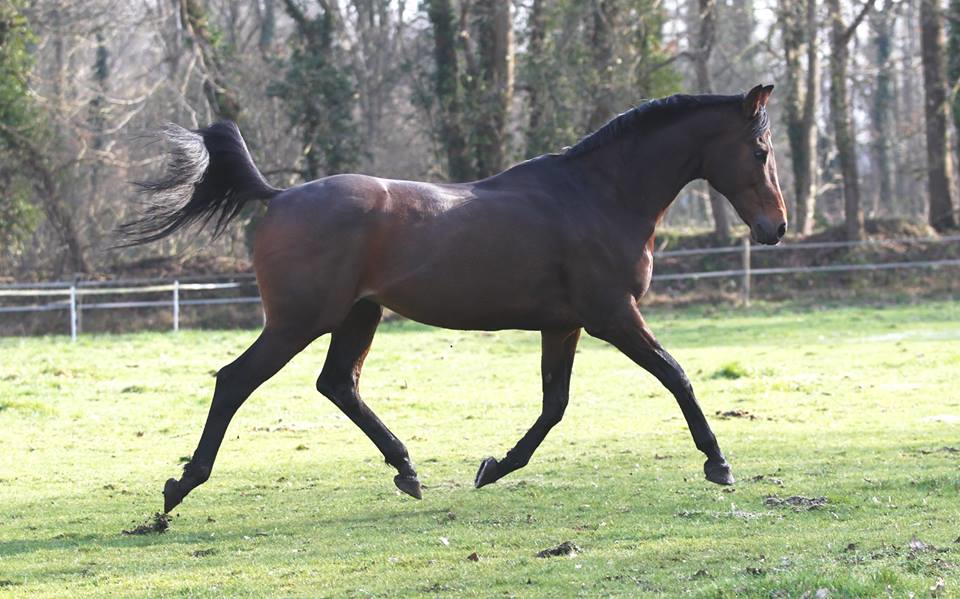
Conny is a visionary breeder, who understood the need for more Thoroughbred in the Dutch sport horse, and searched far and wide until she found her horse. Let her tell you about this journey:
"Since the 1960s/1970s, in my experience, there has not been a really good thoroughbred here in the Netherlands. Over the years, the thoroughbred percentage decreased far too much in the contemporary warmblood horse, we are now roughly speaking about only 25-30% thoroughbred parentage (some say even less) in the contemporary warmblood horse, far too little as far as I am concerned. Also because since about the 1990s the demand for a good thoroughbred has been increasing and there was still nothing coming, I decided to start looking for the right thoroughbred stallion for the warmblood world around 2013. Well, that was quite a search, even sent emails to Russia. Then I was tipped off about Volfonic xx, who lived to my big surprise in the Netherlands. From the first moment I saw him I knew; THIS is the stallion I'm looking for, Volfonic xx really had everything one could wish for.
"The big problem has long been in the fact that people barely know and understand what a good thoroughbred is, and how to look for a good thoroughbred for show jumping and eventing. ...it starts with a correct and suitable built thoroughbred. The next important point is the character, the horse in question must have the will to win and the will to work for you, have a big heart, be easy to handle and I also like a large dose of intelligence. Also important is a good powerful engine. which means: a powerful hindquarter that has a well under step. And I also like correct jumping technique combined with the necessary caution...Then comes the gene package, I look for the right genes and interesting line breeding.
"I am convinced that if you have the right thoroughbred and cross it with the right warmblood...that you get a super jumping/eventing horse...These are the horses I am trying to breed. But if I succeed in breeding a 100% Thoroughbred that has all the above qualities, I can quarantee that this will be the ultimate show jumping/eventing horse!" (Conny van Heeckeren van Kell 6/13/2021)
The thing that strikes me the hardest is that Conny in just 8 years has horses out and doing fantastic jobs with serious riders...just 8 years, amazing.
The jumper seen at article start with Theo van de Vendel is a Volfonic son, as is Lucky, another gifted performer that Theo rides (below).
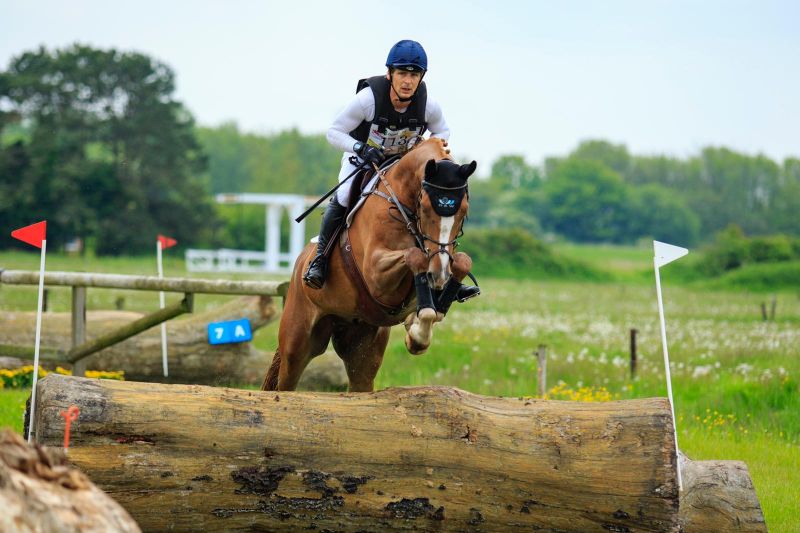
Theo says; "These are horses with quality and what appeals to me: they have a well-behaved and pleasantly cooperative character, good constitution, good construction and they are very sympathetic horses. A big plus is their intelligence and both Volfonic's have a big heart/a lot of courage."
Another international rider, Florinoor Hoogland says about her new Volfonic gelding, Tsjemp: "Happy with Tsjemp. Not that long under saddle, but he still handles everything well. Super cooperative horse. Learns quickly and is fun to rider, always a pleasure to ride him."
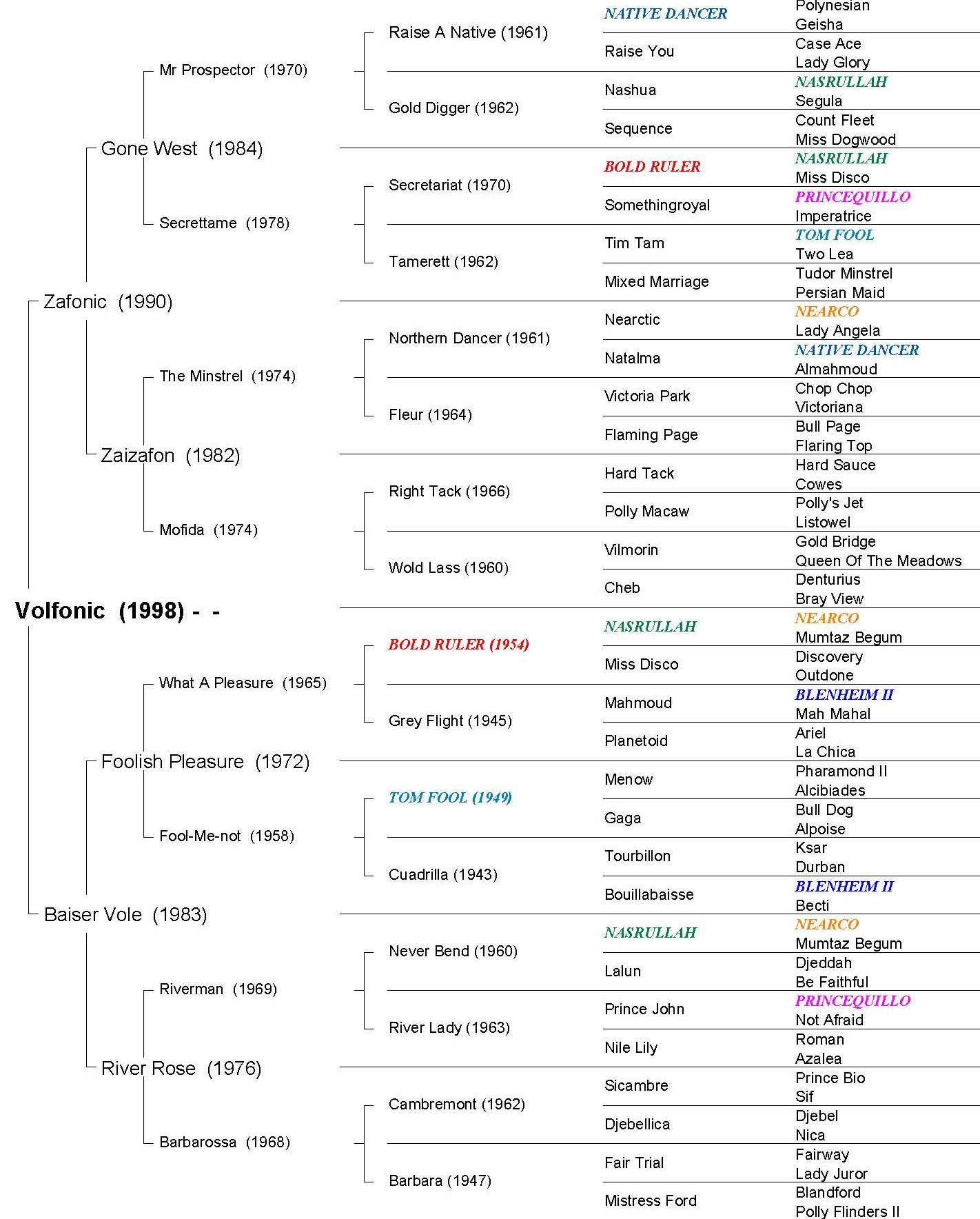
So, how is this full Thoroughbred stallion, purpose-bred for racing, able to consistently transmit excellent non-racing sport abilities to his offspring? A top rate typesetter or improvement sire must be potent in the genetics required in order to pass on his abilities to his young, especially in a cross-breeding situation like this. And Volfonic is extremely potent in proven Thoroughbred sport and jump sources.
Volfonic's greatest potency is in the celebrated sport line of Nasrullah, he is at critical mass level (6x6x5x5) which makes him a Nasrullah typesetting stallion. He also has critical mass in Bold Ruler (5x4), the best son of Nasrullah, sire of Secretariat, and a source of jump (his full brother Independence was a steeplechase racer). Now, Nasrullah was a conundrum for the common warmblood narrative of the 1990s that a sprinting sire will not be a good choice for sport horse breeding. Because he isn't just a sprinter, he is chef-de-race for sprinting, and nothing else, he is sprint through and through. Yet, when Peter Birdsall evaluated the bloodliines of Hunters and Jumpers, Eventers and Dressage horses, he came away with four distinct mega-sires and of those four Nasrullah was #1.
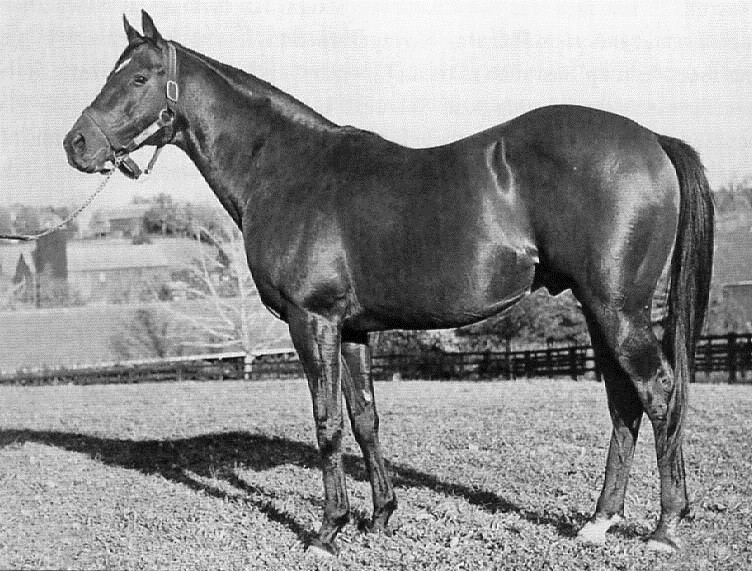
"When all four disciplines are grouped together, the frequency of occurrence of the leading sire lines are as follows: Nasrullah, Man O' War, Princequillo, Native Dancer." (Birdsall 1981)
If you look at the duplications in Volfonic's pedigree you will notice several other strong bloodlines, Native Dancer 5x6, Princequillo 6x6, Tom Fool 6x4...the first two being know jump sources. So Volfonic, a strong jump transmitter is extremely potent in known jump bloodlines. Perhaps the breeders using Thoroughbred who don't see jump improvement, may not be using Thoroughbreds who have a genetic dominance in jump transmitters? It is not enough to have a known line or two in a lineage; it has to be in dominance, especially in cross breeding, in order for the talent to reach the foals. For comparision let's look at what worked for setting a jump in the past.
Jump Typesetters of the Past
We see similar patterns of potency in the great typesetters of the past. Ladykiller was renown as a jump producer, and that only, he didn't produce dressage horses, so his lineage should show us strong sources of the jump.
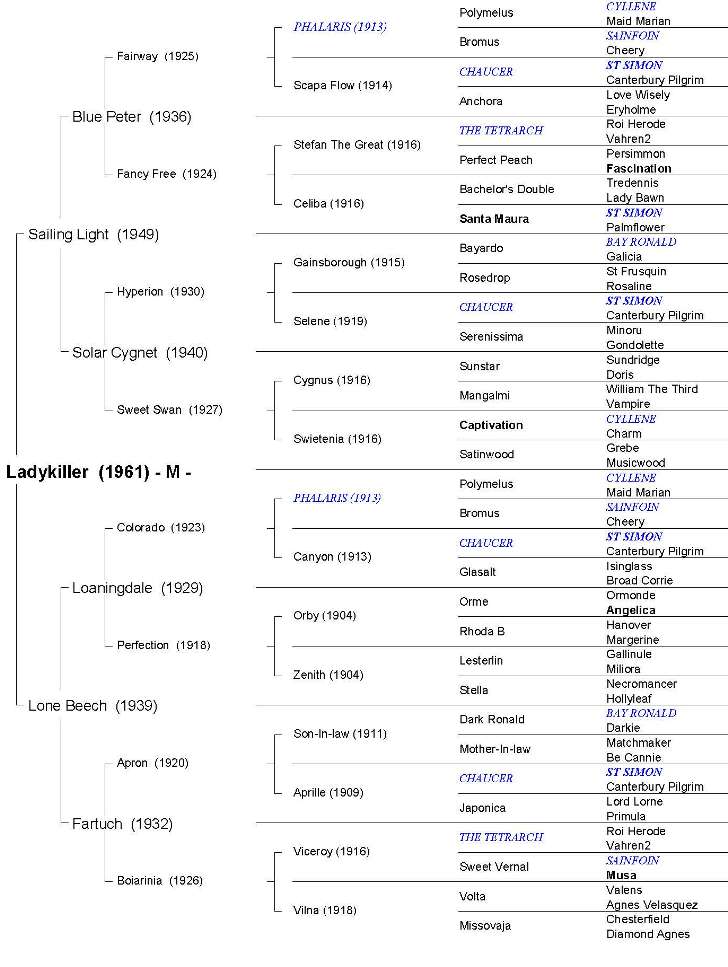
Ladykiller was most definitely a powerful jump transmitter; his genetics transformed the modern Holstein breed. Can you see any potency in him that would explain his genetic reach? It is obvious his most powerful bloodline is Chaucer 5x5x5x5 and secondly, The Tetrarch 5x5. He also has tremendous Cyllene and Galopin strengths, both jump sources. Chaucer (and his half brother Swynford) are out of Canterbury Pilgrim, who is a mare of extraordinary potency in the root jump source of Birdcatcher. Chaucer's sire is St. Simon, a son of Galopin, a jump line, and he is reinforced by a line of his full sister Angelica. And The Tetrarch is inbred to full siblings by a Galopin line sire, out of a Newminster dam. Newminster, sire of Clemence and Hermit, is a powerful root jump source. (Ladykiller pictured below).
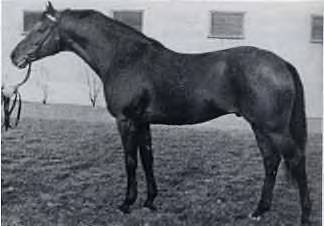
Here are a few other acknowledged jump typesetters: Golden Beaker, sire of the great Clover Hill, was a strong jump line in the Irish horse, he passed on strength in Barcaldine, Newminster and Birdcatcher via lines of Hurry On and Canterbury Pilgrim. Precipitation, a son of Hurry On was also a celebrated jump sire, and he carried 10 lines of Newminister in 7 generations (critical mass) and had a secondary Birdcatcher strength. The great American jump line of Fair Play (sire of Man O' War) was a genetic warehouse of Newminster 4x7x5 and Birdcatcher 7x5x6x7. You can discover more jump bloodlines on Hall of Fame Show Jumpers.
The Next Generation
Conny got Volfonic when he was past his prime, now he is 23, and he is still strong but someday she will have to retire him. She had the good sense to breed a replacement for her sire, and in my opinion she created an even better genetic transmitter with his son Saqr.
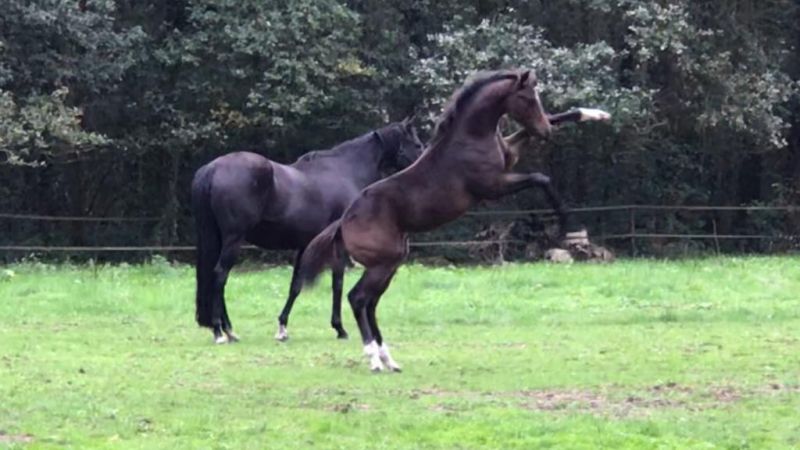
I am very enthusiastic about Saqr's genetics. Volfonic is a strong Nasrullah typesetting stallion, when she bred Saqr she targeted Volfonic's best bloodlines, and the result is a very potent full Thoroughbred stallion. The choice of this mare was genius, and for breeders who want to learn how to build up from your existing stock, this pedigree is a good illustration. As you can see there is a double of Secretariat, Riverman, Kalamoun and Flaming Page. These are all superlines; Secretariat needs no explanation, Riverman is one the great modern broodmare sires, here by daughters, Kalamoun accesses the Nasruallah power and brings in his full sister Rivaz, and Flaming Page is a mare for the ages, and her two bests offspring: Fleur dam of The Minstrel and Nijinksy are here in this colt. This is genetic gold.
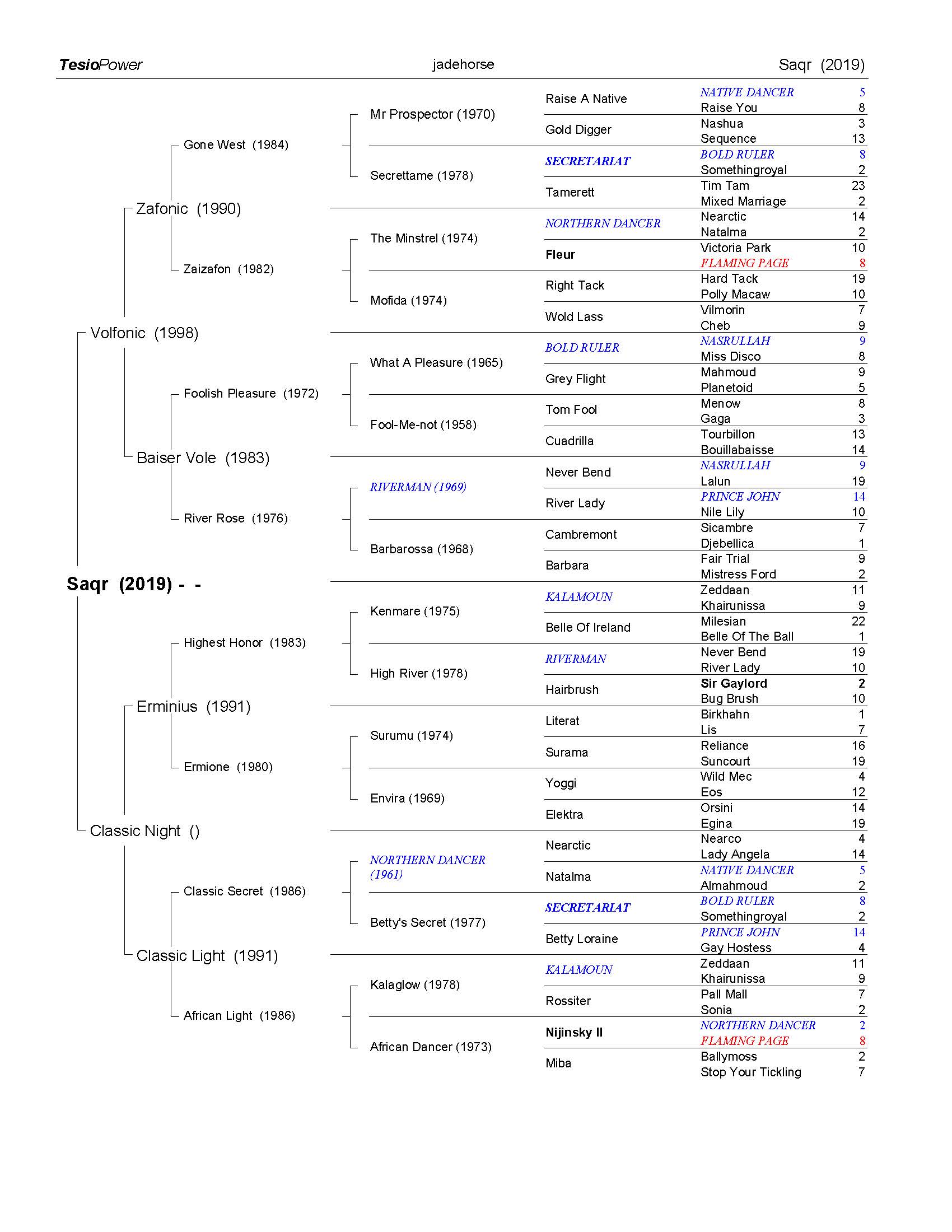
This young colt will not only be a sport horse breeder's dream, but he is a important option for the racing breeder as it is not often you see such excellent sound bloodlines in power in one place.
Conclusion:
The Thoroughbred never lost its jump. It is a genetic impossibility for genes present in a breed with a closed studbook to disappear, especially such dominant jumping genes. Cross-breeding, however, can and does change genetic dominance for better or worse. A great typesetter for jump ability--no matter the breed, must be dominant in the jump genetics. The jump setters of yesteryear illustrate this principle plainly. The examples of today we witnessed of the jumpers in the upper level steeplechase, and the example above of a successful improvement sire for the warmbloods demonstrate that the Thoroughbred of today does indeed have the jump, it is not lost, and there is no real evidence that the upper level jumpers in warmbloods exceed the percentage of those in Thoroughbreds. The promotion of the idea that only 'purpose-bred' warmbloods are real sport horses is nothing more than the consistent marketing propaganda the WBFSH has poured out since the 1990s.
Independent Fact Checkers, at New Vocations Retired Racehorse Network (FB) have swung into action to give me a beating.
My article has been fact checked and found guilty of containing unsound and incorrect information and logical fallacy! (Fact checker Huehn 6/16/21). Wow. I sort of liked my article, and most of the readers did also. But I had the nerve to say in it that it was genetically impossible for the jump to be bred out of the Thoroughbred without cross breeding, as it is part of the breed. This stance triggered the fact police, and not just one, but three.
Let me quote from my favorite:
"..if a breeding effort within a breed are focused on one thing, such as flat racing, and jumping ability doesn't happen to go along with the trait for flat racing, then it will become increasing more difficult overtime to find jump ability." and it was also said: "selective breeding can absolutely make gene-linked traits disappear." (Kellyn Renee Huehn, June 16, 2021)
One good fact check deserves another I say. The Thoroughbred, purebred since 1791 in Great Britain and in America since 1868, with a closed studbook, which means since that time it has a closed genetic pool. Therefore what the breed contained then is what it contains now. My critics are saying that performance practice, in this case, flat racing will overtime will absolutely cause the jump trait to disappear. When exactly this is to occur is not mentioned...perhaps it is like Darwinism, that in a few billion years it will happen? Anyway her scientific term of "doesn't happen to go along" is a new one for me too. Seeing the Thoroughbred always had a jump and always raced, it its sort of hard to see where this 'not go along" scientific principle thing occurs, because historically the two traits have always gone along, and there has always been steeplechase racing because of that. Maybe if enough time elapses, its only 230 years.
She and other critics have this idea that the Thoroughbred somehow has in the short window of time from the days of Gem Twist (40 years) for example, erased the jump trait from its genotype. Interesting concept, but as I said it is not possible mathematically or genetically, because the trait is part of the breed, it permeates it as does the gallop, and always has been, and it is so strong in the Thoroughbred, that the Hunter Horse (precursor to the sport horse of today) was almost always bred by crossing Thoroughbred with another breed. The Warmbloods of today are essentially Hunters. The first recorded steeplechase was in 1752 in Ireland, and hunting on horseback, which requires the ability to clear fences and stone walls, was always done, even before the Thoroughbred became a breed, its ancestors were hunted, and they were always raced.
My contention is that performance choice will encourage the horses with the best genetics for that sport to be bred on, its a no-brainer, but in a closed gene pool it cannot cause other traits to "disappear," rather it can make them less dominant. But as any linebreeder knows, all you have to do is choose the correct mate to bring those less dominant genetics right back to the fore and into the phenotype...I do this all the time with my own herd. Any trait can be eliminated by breeding to a horse that does not carry it, which in this case would be a non-Thoroughbred. This is how we breed out faults in sport horses; we select a mate that corrects the fault, and then we keep the offspring that are fault-free to breed on from.
My critics contention is that if flat racing is chosen, it eliminates the jump. But that is not historically true, nor is it sound genetics. Genes don't disappear, they separate and a half is passed on in each mating, so unless a horse does not carry the jump trait, whichever genes are involved in jump transmission (unknown at this time), the half from the Thoroughbred mate would just reinforce the trait.
Historically when a change occurred in a breed it was because another outside element was added. And changes have occurred in the Thoroughbred over its history. The Thoroughbred lost speed, stamina, and soundness with the unfortunate crossing in of the English Cart Horse (ancestor of the Shire Horse). (See Bloodlines.net/highflyer/ "The Half-Crown English Cart Horse" by Hardiman, or The Horse in all its Varieties and Uses by Lawrence 1829, or Herbert's Frank Forester's Horse and Horsemanship of the United States and British Provinces of North America, vol.II, or my own Standardbred Sport Horses 2017, or Become Your Own Tesio 2021). It all started with this mare:
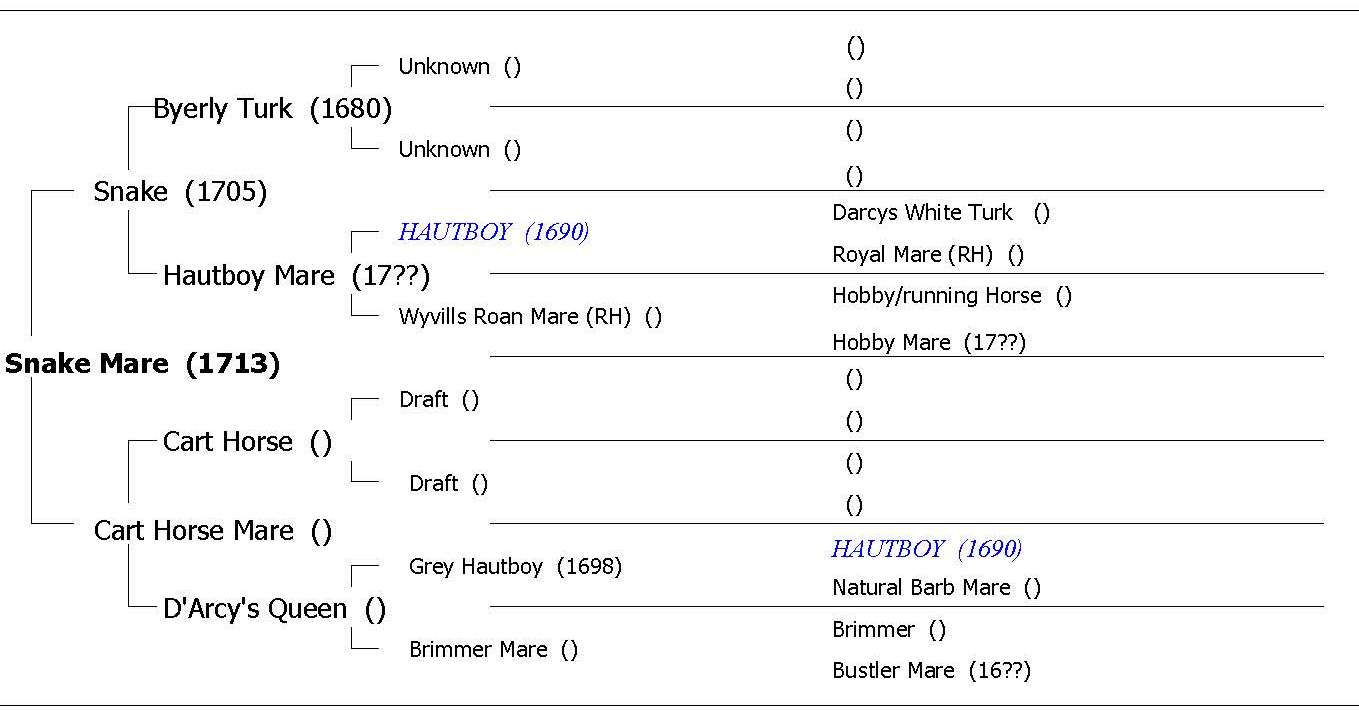
Snake Mare 1713, born when the breed was still in its formation stage and the studbook had not been made, and so it was this one bit of draft spread throughout the breed through some very prolific descendants, such as Sampson and Cantatrice and others, and it took a while, but the effects were being complained about here in the States by 1800. The changes in the Thoroughbred was so detrimental that it caused our great horse breeders Randolph, Cocke, and Tayloe to complain about it in writing and it resulted in the first organized foundation movement in this country. It took almost 90 years for the effects of this change in the genes to build to such a state that action was required to save our studs from ruin. It was the introduction of a foreign genotype, which carried genes that were contrary to the performance abilities, to 'erase' soundness, stamina, speed and good temperament in some strains. It was not the change from the heat racing form to the classic race test that caused this, it was the introduction of this non-racing, unsound genes. Overtime, the negative effects of this invasion have been diluted, and mostly became less dominant, but time did not eliminate her genes, and even today, now and then, a Thoroughbred is born that has a huge draft head, a draft butt or the horrible shelly feet. Her shadow is huge.
If my fact checker's premise that performance choice causes a disappearance of certain other then unused traits, then explain the Standardbred. It is a breed that is homozygous for the gait-keeper gene, the speed gene and the newly discovered stamina gene (Polaski 2018). Yes, a horse can have both speed and stamina--think Secretariat. I pointed this out in one of my responses, but by that time they were not digesting anything I said.
While still the parent breed, the Running Horse, a trotting performance test was set in 1818 at a 3:00 mile, which jump started a new breed: the American Trotter. Breeders were from then on choosing their stock from those that could qualify. By 1871 the speed at the trot was so consolidated in the breed that they established a register of horses that raced in 2:40 or under. By 1879, the bar was set at 2:30 mile, and the Standardbred was born. During the 1800s heat racing was also popular, and even extreme stamina races of 50-100 miles, so stamina was certainly in the gene pool. But by 1879 those distance tests were abandoned for the mile test, and so it has been to our day. So, if my critics are correct, then the Standardbred, which no longer uses the stamina, would have a genotype that had speed only, the stamina would have evaporated from the breed. But when Dr. Polaski tested the breeds for presence of the stamina gene only three were found to be homozygous: the Polish Heavy Draft, the Arabian and the Standardbred. What? In those 140 years of non-use the stamina did not disappear, and did not even become heterozygous? No, it is still homozygous for stamina, it is part of the breed, and unless the studbook opens to strains from other breeds, which is unlikely, because the Standardbred is the fastest trotting and pacing breed in the world, then the stamina will remain.
Sticking with the Thoroughbred, recently we have all been delighted to see the white Thoroughbreds being raised in Japan, and even one of them, a mare, has won a stakes race. A few years ago we were fascinated by the son of Bodemeister that was a true Paint Horse, and lately Palomino and Buckskin Thoroughbreds have been cropping up. I never saw any of those variations in coat even 30 years ago. But now, with increasing frequency they are appearing. What happened? Did someone secretly cross in a horse with a strong splash gene, or cross in a cremello horse, or maybe a paint horse? Those colors were not seen on racetracks for maybe a hundred years. If this theory, that selection for traits can erase previous traits was correct, then these beautiful creatures would not be possible in the purebred Thoroughbred. Wild coloring like these were long discouraged in the Thoroughbred, selection was for solid colors of bay, chestnut, black and grey. But these unused variations were never erased from the gene pool, and so modern day breeders have been able to retrieve those elements from the genotype and make them dominant again.
So I find my fact checkers have lack of context and incorrect facts.
Senior Senator--champion steeplechaser